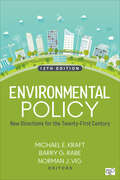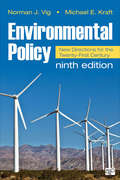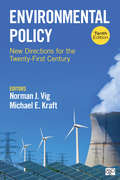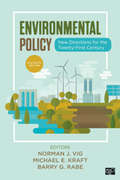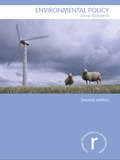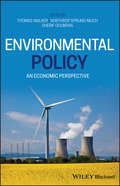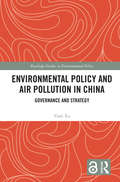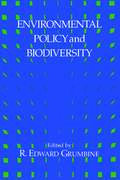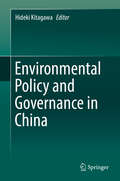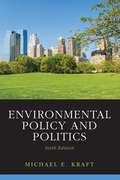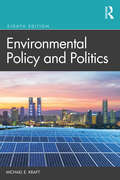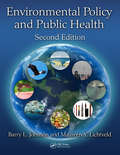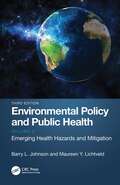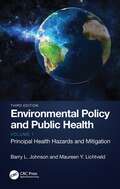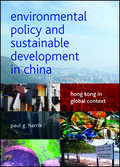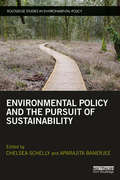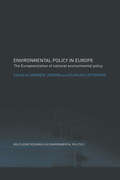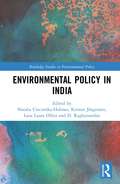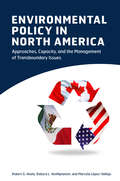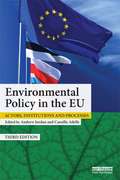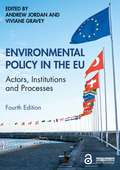- Table View
- List View
Environmental Policy: New Directions for the Twenty-First Century
by Michael E. Kraft Barry G. RabeAs environmental issues continue to become more prevalent in society and surrounding policy challenges become more complex, Environmental Policy once again brings together top scholars to evaluate the changes and continuities in American environmental policy since the late 1960s and their implications for current policy. Students will learn to decipher the underlying trends, institutional constraints, and policy dilemmas that shape today’s environmental politics as they evaluate approaches to future challenges.
Environmental Policy: New Directions for the Twenty-First Century
by Michael E. Kraft Barry G. RabeAs environmental issues continue to become more prevalent in society and surrounding policy challenges become more complex, Environmental Policy once again brings together top scholars to evaluate the changes and continuities in American environmental policy since the late 1960s and their implications for current policy. Students will learn to decipher the underlying trends, institutional constraints, and policy dilemmas that shape today’s environmental politics as they evaluate approaches to future challenges.
Environmental Policy: New Directions for the Twenty-First Century
by Mr Michael E. Kraft Mr Norman J. VigAuthoritative and trusted, Environmental Policy convenes top scholars to evaluate the impact of past environmental policy while anticipating its future implications, helping students decipher the underlying trends, institutional constraints, and policy dilemmas that shape environmental politics. In the Ninth Edition, editors Norman Vig and Michael Kraft offer coverage of the latest issues, including the energy and natural resource policy dilemmas, sustainable cities, and the environmental impact of food production and consumption. A new concluding chapter ties the contributed material together with an assessment of the remaining environmental policy challenges for the 21st century.
Environmental Policy: New Directions for the Twenty-First Century
by Mr Michael E. Kraft Mr Norman J. VigAuthoritative and trusted, Environmental Policy once again brings together top scholars to evaluate the changes and continuities in American environmental policy since the late 1960s and their implications for the twenty-first century. You will learn to decipher the underlying trends, institutional constraints, and policy dilemmas that shape today’s environmental politics. The Tenth Edition examines how policy has changed within federal institutions and state and local governments, as well as how environmental governance affects private sector policies and practices. The book provides in-depth examinations of public policy dilemmas including fracking, food production, urban sustainability, and the viability of using market solutions to address policy challenges. Students will also develop a deeper understanding of global issues such as climate change governance, the implications of the Paris Agreement, and the role of environmental policy in the developing world. Students walk away with a measured yet hopeful evaluation of the future challenges policymakers will confront as the American environmental movement continues to affect the political process.
Environmental Policy: New Directions for the Twenty-First Century
by Mr Michael E. Kraft Mr Norman J. VigAuthoritative and trusted, Environmental Policy once again brings together top scholars to evaluate the changes and continuities in American environmental policy since the late 1960s and their implications for the twenty-first century. You will learn to decipher the underlying trends, institutional constraints, and policy dilemmas that shape today’s environmental politics. The Tenth Edition examines how policy has changed within federal institutions and state and local governments, as well as how environmental governance affects private sector policies and practices. The book provides in-depth examinations of public policy dilemmas including fracking, food production, urban sustainability, and the viability of using market solutions to address policy challenges. Students will also develop a deeper understanding of global issues such as climate change governance, the implications of the Paris Agreement, and the role of environmental policy in the developing world. Students walk away with a measured yet hopeful evaluation of the future challenges policymakers will confront as the American environmental movement continues to affect the political process.
Environmental Policy: New Directions for the Twenty-First Century (The\harpercollins Public Policy Ser.)
by Barry G. Rabe Michael E. Kraft Norman J. VigAuthoritative and trusted, Environmental Policy once again brings together top scholars to evaluate the changes and continuities in American environmental policy since the late 1960s and their implications for the twenty-first century. Students will learn to decipher the underlying trends, institutional constraints, and policy dilemmas that shape today’s environmental politics. The Eleventh Edition examines how policy has changed within federal institutions and state and local governments, as well as how environmental governance affects private sector policies and practices. There are five new chapters in this edition that examine the public’s opinion on the environment, courts, energy policy, natural resource agencies and policies, and the political economy of green growth. The book has been updated to reflect the Trump administration′s four years of policy changes and students will walk away with a measured, yet hopeful evaluation of the future challenges that policymakers will confront as the American environmental movement continues to affect the political process.
Environmental Policy: New Directions for the Twenty-First Century (The\harpercollins Public Policy Ser.)
by Barry G. Rabe Michael E. Kraft Norman J. VigAuthoritative and trusted, Environmental Policy once again brings together top scholars to evaluate the changes and continuities in American environmental policy since the late 1960s and their implications for the twenty-first century. Students will learn to decipher the underlying trends, institutional constraints, and policy dilemmas that shape today’s environmental politics. The Eleventh Edition examines how policy has changed within federal institutions and state and local governments, as well as how environmental governance affects private sector policies and practices. There are five new chapters in this edition that examine the public’s opinion on the environment, courts, energy policy, natural resource agencies and policies, and the political economy of green growth. The book has been updated to reflect the Trump administration′s four years of policy changes and students will walk away with a measured, yet hopeful evaluation of the future challenges that policymakers will confront as the American environmental movement continues to affect the political process.
Environmental Policy
by Jane RobertsEvidence of climate change, resource shortages and biodiversity loss is growing in significance year by year. This second edition of Environmental Policy explains how policy can respond and bring about greater sustainability in individual lifestyles, corporate strategies, national policies and international relations. The book discusses the interaction between environmental and human systems, proposing environmental policy as a way to steer human systems to function within environmental constraints. The second edition has been completely updated to reflect advances in scholarship (for example developments in governance theory) and the increasing primacy of climate policy within environmental policy as a whole. Key political, social and economic concepts are used to explain how effective environmental policies can be designed, implemented and evaluated. Environmental problems, the role of human beings in creating them and sustainable development are all introduced. Environmental policy formulation, implementation and evaluation are discussed within three specific contexts: the firm, the nation state and at an international level. The book reviews the relationship of economics, science and technology to environmental policy. It ends by reflecting upon the predicament of humankind in the twenty-first century and the potential of achieve sustainability through the use of the environmental policy ‘toolbox’. Environmental Policy is an accessible text with a multi-disciplinary perspective. Lively case studies drawn from a range of international examples – and completely updated for this second edition – illustrate issues such as climate change, international trade, tourism and human rights. It includes chapter summaries, suggestions for further reading and links to relevant web resources.
Environmental Policy: New Directions for the Twenty-First Century
by Mr Norman J. Vig Mr Michael E. KraftAuthoritative and trusted, Environmental Policy convenes top scholars to evaluate the impact of past environmental policy while anticipating its future implications, helping students decipher the underlying trends, institutional constraints, and policy dilemmas that shape environmental politics. In the Ninth Edition, editors Norman Vig and Michael Kraft offer coverage of the latest issues, including the energy and natural resource policy dilemmas, sustainable cities, and the environmental impact of food production and consumption. A new concluding chapter ties the contributed material together with an assessment of the remaining environmental policy challenges for the 21st century.
Environmental Policy: An Economic Perspective
by Thomas Walker Northrop Sprung-Much Sherif GoubranEXPAND YOUR UNDERSTANDING OF HOW ENVIRONMENTAL POLICY AFFECTS BUSINESS, THE ECONOMY, AND YOUR LIFE WITH THIS ESSENTIAL RESOURCE Environmental Policy: An Economic Perspective offers readers a comprehensive examination of the ever-broadening scope and impact of environmental policy, law, and regulation. Editors Thomas Walker, Northrop Sprung-Much, and Sherif Goubran walk readers through a variety of subjects while maintaining a global perspective on the expanding role of environmental law. This book takes a pragmatic and practical approach to its subject matter, showing readers the real impact across the world of different kinds of environmental policy. Among other topics, Environmental Policy: An Economic Perspective tackles: Climate change legislation Water conservation and pricing Biodiversity of the marine environment Wildlife ranching Emission trading schemes Green job strategies Sustainable investing Written for undergraduate and graduate students in any field affected by environmental legislation and policy, this book also belongs on the shelves of anyone who seeks to better understand the increasingly important role of environmental policy on their business and life.
Environmental Policy and Air Pollution in China: Governance and Strategy (Routledge Studies in Environmental Policy)
by Yuan XuThis book systematically analyzes how and why China has expectedly lost and then surprisingly gained ground in the quest to solve the complicated environmental problem of air pollution over the past two decades. Yuan Xu shines a light on how China’s sulfur dioxide emissions rose quickly in tandem with rapid economic growth but then dropped to a level not seen for at least four decades. Despite this favorable mitigation outcome, Xu details how this stemmed from a litany of policy stumbles within the Chinese context of no democracy and a lack of sound rule of law. Throughout this book, the author examines China’s environmental governance and strategy and how they shape environmental policy. The chapters weave together a goal-centered governance model that China has adopted of centralized goal setting, decentralized goal attainment, decentralized policy making and implementation. Xu concludes that this model provides compelling evidence that China’s worst environmental years reside in the past. This book will be of great interest to students and scholars of Chinese environmental policy and governance, air pollution, climate change and sustainable development, as well as practitioners and policy makers working in these fields.
Environmental Policy and Biodiversity
by R. Edward GrumbineScientists and policymakers must work together if solutions to the biodiversity crisis are to be found. Yet all too often, scientific data are unknown or incomprehensible to policymakers, and political realities are not fully appreciated by scientists.Environmental Policy and Biodiversity addresses that problem by presenting both an overview of important concepts in the field of conservation biology and an examination of the strengths and limitations of the policymaking process. Topics covered include: the ethical and scientific bases of conservation biology the effectiveness of existing environmental policy in protecting biodiversity case studies from California, the Great Lakes region, southern Appalachia, and the Florida panhandle an examination of overall environmental policy goals and processes Featuring provocative and clearly argued essays from a range of disciplines, Environmental Policy and Biodiversity provides resource professionals with valuable insight into conservation issues, and can serve as a useful tool in both graduate and undergraduate courses in conservation biology and environmental policy.
Environmental Policy and Governance in China
by Hideki KitagawaThis book focuses on how to create an environmentally friendly society in China from the viewpoint of environmental law and policy. The authors accessed a great number of valuable sources not available in English, and interviewed various scholars and public officials, in order to analyze the environmental policies in China while comparing some of the features to Japan. The book stresses the importance of introducing a brand-new policy of central and local government, and analyses why these policies have not been executed effectively in the local society. In addition to the economy-oriented policy and spirit of the Chinese nation, which are the main causes, this book also highlights shortcomings in the inspection system, information management, and the extremely low degree of public participation as important aspects to focus on in order to tackle the current problems. The individual chapters will help readers to understand the environmental issues in China in depth, and provide guidance on resolving the issues in China and in developing countries that are now or soon will be facing the challenge of combining economic growth and environmental improvement. Air, water and soil pollution are serious challenges in China. The deterioration of the environment often leads to rioting that influences social stability, which is also a great concern to foreign investors. This book will be of interest to a professional audience such as policymakers, journalists, members of environmental NGOs, managers and employees who do business with China, as well as academic researchers and students.
Environmental Policy and Politics
by Michael KraftCovering global threats such as climate change, population growth, and loss of biodiversity, as well as national, state, and local problems of environmental pollution, energy use, and natural resource use and conservation, Environmental Policy and Politics provides a comprehensive overview of U.S. policy-making processes, the legislative and administrative settings for policy decisions, the role of interest groups and public opinion in environmental politics, and the public policies that result. It helps readers understand modern environmental policy and its implications, including the need for a comprehensive and integrated approach to problem solving.
Environmental Policy and Politics
by Michael E. KraftFor more than twenty years, Environmental Policy and Politics has kept instructors and students abreast of the challenges presented by contemporary environmental, energy, and natural resource problems in the United States. Now in its eighth edition, Michael E. Kraft has updated his definitive text to capture the changing nature of environmental problems as well as policy proposals made through 2020. Drawing from work within environmental science, policy analysis, and political science, this text continues to help readers think critically about how best to address problems through a variety of public policy tools and strategies at all levels of government. Important updates to this new edition include: • The latest information about environmental challenges and governmental responses to them, with extensive citation of key sources and websites. • Key political and policy decisions through late 2020, including presidential appointments, budgetary decisions, major legislative initiatives, and congressional actions. • New learning objectives to facilitate student understanding of key concepts and their applications, arguments advanced over environmental challenges and policies, and the goals and methods of environmental policy analysis. • Coverage of new topics that have emerged during the Trump presidency, including the Clean Power Plan repeal and reduction of environmental regulation, climate change, land conservation, changes in natural resources policies, and a comparison of the Republican and Democratic positions on climate change in 2020. • Updated summaries of scientific studies, government reports, and policy analyses. • Revised discussion questions and new suggested readings. Environmental Policy and Politics is an essential resource for upper level undergraduate and graduate students in political science and environmental studies looking for an accessible, well-researched, and up-to-date text, written with style and flair.
Environmental Policy and Public Health
by Barry L. Johnson Maureen Y. LichtveldAs with the first edition, this second edition describes how environmental health policies are developed, the statutes and other policies that have evolved to address public health concerns associated with specific environmental hazards, and the public health foundations of the policies. It lays out policies for what is considered the major environmental physical hazards to human health. Specifically, the authors describe hazards from air, water, food, hazardous substances, and wastes. To this list the authors have added the additional concerns from climate change, tobacco products, genetically-modified organisms, environment-related diseases, energy production, biodiversity and species endangerment, and the built environment. And as with the first edition, histories of policymaking for specific environmental hazards are portrayed. This edition differs from its antecedent in three significant themes. Global perspectives are added to chapters that describe specific environmental hazards, e.g., air pollution policies in China and India. Also there is the material on the consequences of environmental hazards on both human and ecosystem health. Additionally readers are provided with information about interventions that policymakers and individuals can consider in mitigating or preventing specific environmental hazards.
Environmental Policy and Public Health: Emerging Health Hazards and Mitigation, Volume 2
by Barry L. Johnson Maureen Y. LichtveldWritten by environmental health experts with long teaching and professional careers in policy and public health, the third edition of Environmental Policy and Public Health comprises two volumes, addressing key physical hazards in the environment that impact public health. The first volume on Principal Health Hazards and Mitigation is complemented by the second volume, Emerging Health Hazards and Mitigation. Volume 2 discusses emerging health hazards and mitigation including environment-related infectious diseases, COVID-19 pandemic, social justice, and drugs and public health. New in this volume are a chapter on firearms violence as a public health hazard, a chapter on transportation and how built environments can affect human health and social well-being, and a chapter on noise and light pollution. As human populations increase and technology adds more devices to daily use that generate noise and light, adverse human and ecological health effects have become recognizable and require time-sensitive policy actions to mitigate and where possible prevent adverse health effects. Each chapter explains with great clarity how new environmental health issues are translated into public health policies. The volume concludes with case studies and practice questions to facilitate interactive learning for upper-level undergraduate and graduate students taking courses in public health and environmental sciences. The case studies and practice questions allow for a diverse portfolio of in-person and hybrid pedagogical strategies and tools at the fingertips of faculty who not only teach policy courses but whose course topics have policy relevance, such as climate and health.
Environmental Policy and Public Health: Principal Health Hazards and Mitigation, Volume 1
by Barry L. Johnson Maureen Y. LichtveldWritten by environmental health experts with long teaching and professional careers in policy and public health, the third edition of Environmental Policy and Public Health comprises two volumes addressing key physical hazards in the environment that impact public health. The first volume on Principal Health Hazards and Mitigation is complemented by the second volume, Emerging Health Hazards and Mitigation. The health of the environment is inextricably linked to that of people. Thoroughly updated, Volume 1 describes how the quality of air, water, and food is threatened by the presence of toxic substances and explains why climate change is a global health priority already impacting human health and the environment. The mitigations discussed in this volume are twofold: policies that are intended for control of specific hazards and suggested hazard interventions. The role of policy in addressing each of these key environmental health areas is extensively discussed in this volume as well. Each chapter explains step by step how new environmental health issues are translated into public health policies and concludes with practice questions to facilitate interactive learning for upper-level undergraduate and graduate students taking courses in public health and environmental sciences. The step-by step approach, as well as the case studies and practice questions, allow for a diverse portfolio of in-person and hybrid pedagogical strategies and tools at the fingertips of faculty who not only teach policy courses, but whose course topics, such as climate and health, have policy relevance.
Environmental policy and sustainable development in China: Hong Kong in Global Context
by Paul G. HarrisDrawing on practices and theories of sustainability, Environmental policy and sustainable development in China explores the prospects for achieving environmentally benign economic and social development in China and beyond. Using the Chinese 'world city' of Hong Kong as a backdrop and case study, it introduces major conceptions of sustainability, describes historical and political contexts for environmental policymaking, and analyses key challenges related to sustainable development, including air pollution, water quality, waste, transport and climate change. The book will be a valuable and unique resource for students, teachers and readers interested in environmental policy, sustainable development and ecological governance, especially in China and Hong Kong. All of the author's royalties from sales of this book will be donated by Policy Press to Friends of the Earth (Hong Kong) and WWF (Hong Kong).
Environmental Policy and the Pursuit of Sustainability (Routledge Studies in Environmental Policy)
by Chelsea Schelly Aparajita BanerjeeIt is increasingly apparent that human activities are not suitable for sustaining a healthy global environment. From energy development to resource extraction to use of land and water, humans are having a devastating effect on the earth’s ability to sustain human societies and quality lives. Many approaches to changing the negative environmental consequences of human activities focus on one of two options, emphasizing either technological fixes or individual behavior change to reduce environmental harms through sustainable consumption habits. This book takes a different approach, focusing on the role of environmental policy in shaping the possibilities for and creating hindrances to pursuing more sustainable use of environmental resources. This unique compilation examines environmental policy through empirical case studies, demonstrating through each particular example how environmental policies are formed, how they operate, what they do in terms of shaping behaviors and future trajectories, and how they intersect with other social dynamics such as politics, power, social norms, and social organization. By providing case studies from both the United States and Mexico, this book provides a cross-national perspective on current environmental policies and their role in creating and limiting sustainable human futures. Organized around four key parts – Water; Land; Health and Wellbeing; and Resilience – and with a central theme of environmental justice and equity, this book will be of great interest to students and scholars of environmental policy and sustainability.
Environmental Policy in Europe: The Europeanization of National Environmental Policy (Environmental Politics #Vol. 7)
by Duncan Liefferink Andrew JordanThe continuing development of the European Union (EU) is transforming policy and politics in its member countries, and possibly in an even larger number of potential members. This book offers a detailed investigation of the Europeanization of national environmental policy in ten western European countries since 1970.By blending state-of-the-art theories with fresh empirical material on the many manifestations of Europeanization, it sheds new light on the dynamics that are decisively reshaping national environmental policy. It also offers an original assessment of how far Europeanization has produced greater policy convergence in western Europe.Throughout, the approach taken is genuinely comparative, drawing on the insights provided by leading country specialists.
Environmental Policy in India (Routledge Studies in Environmental Policy)
by Natalia Ciecierska-Holmes Kirsten Jörgensen Lana Laura Ollier D. RaghunandanThis book systematically introduces historical trajectories and dynamics of environmental policy and governance in India. Following the features of environmental policy in India as outlined in Chapter 1, subsequent chapters explore domestic and international factors that shape environmental policy in the country. The chapters examine the interplay between governmental and non-governmental actors, and the influence of social mobilisation and institutions on environmental policy and governance. Analysing various policy trajectories, the chapters identify and explore five central environmental policy subsystems: forests, water, climate, energy and city development. The authors drill down into the social, economic, political and ecological dimensions of each system, shedding light on why striking a balance between national economic growth and environmental sustainability is so challenging. Drawing on political science theories of policy processes and related theoretical concepts, this innovative edited volume will be of great interest to students and scholars of environmental policy and politics and South Asian studies more broadly.
Environmental Policy in North America: Approaches, Capacity, And The Management Of Transboundary Issues
by Robert G. Healy Debora L. VanNijnatten Marcela López-VallejoThis comprehensive analysis of key issues in North American environmental policy provides an overview of how the US, Mexico, and Canada differ in their environmental management approaches and capacity levels, and how these differences play into cross-border cooperation on environmental problems. The book offers insights into transboundary cooperation both before and after NAFTA, and presents a framework for making environmental interaction more effective in the future. The book is organized into two parts. The first, more general, section compares the national contexts for environmental management in each country—including economic conditions, sociocultural dynamics, and political decision-making frameworks— and shows how these have led to variations in policy approaches and levels of capacity. The authors argue that effective environmental governance in North America depends on the ability of transboundary institutions to address and mediate these differences. The book's second section illustrates this argument, using four case studies of environmental management in North America: biodiversity and protected areas, air pollution (smog); greenhouse gas reduction, and genetically modified crops.
Environmental Policy in the EU: Actors, institutions and processes
by Andrew Jordan Camilla AdelleThe European Union (EU) has a hugely important effect on the way in which environmental policies are framed and implemented in many different parts of the world, but especially Europe. The new and comprehensively revised edition of this well-known textbook provides a state-of-the-art analysis of all the EU’s environmental policies. Comprising five parts, it covers the rapidly changing context in which EU environmental policies are made, the key actors who interact to co-produce policy and the most salient dynamics of policy making, ranging from decision making through to implementation and evaluation. Written by leading experts in the field, individual chapters examine how the EU is responding to a multitude of different problems including biodiversity loss, climate change, energy insecurity, and water and air pollution. They tease out the many important ways in which the EU's policies on these topics co-evolve with national and international environmental policies. In this third edition a mixture of learning features are employed to ensure that undergraduate and postgraduate students fully understand how EU policies in this vital area developed in the past and how they are now adapting to the rapidly evolving challenges of the twenty-first century.
Environmental Policy in the EU: Actors, Institutions and Processes
by Andrew Jordan Viviane GraveyThe European Union (EU) has a hugely important effect on the way in which environmental policies are framed, designed and implemented in many parts of the world, but especially Europe. The new edition of this leading textbook provides a state-of-the-art analysis of the EU’s environmental policies. Comprising five parts, Environmental Policy in the EU covers the rapidly changing context in which EU environmental policies are made, the key actors who interact to co-produce them and the most salient dynamics of policy making, ranging from agenda setting and decision making, through to implementation and evaluation. Written by leading international experts, individual chapters examine how the EU is responding to a multitude of different challenges, including biodiversity loss, climate change, energy insecurity, and water and air pollution. They tease out the different ways in which the EU’s policies on these topics co-evolve with national and international environmental policies. In this systematically updated fourth edition, a wider array of learning features are employed to ensure that readers fully understand how EU environmental policies have developed over the last 50 years and how they are currently adapting to the rapidly evolving challenges of the twenty-first century, including the COVID-19 pandemic. It is an essential resource for undergraduate and postgraduate students studying environmental policy and politics, climate change, environmental law and EU politics more broadly.
